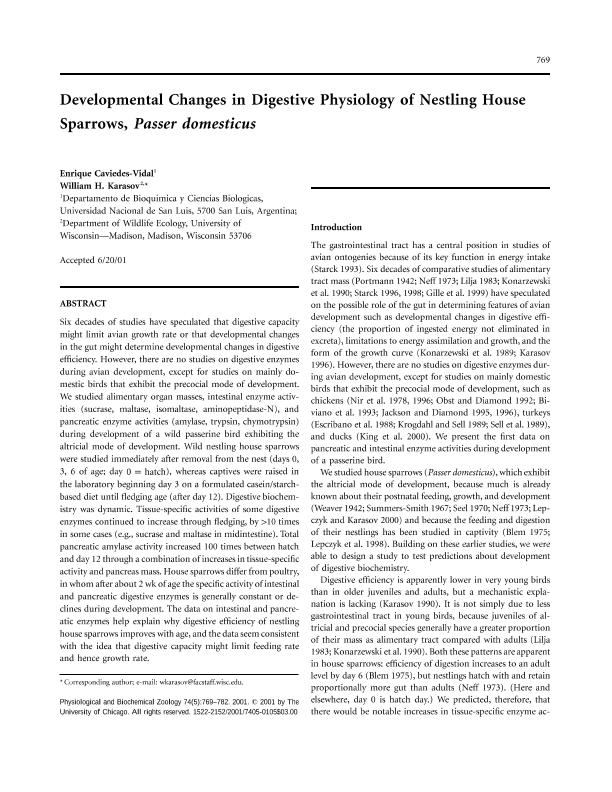Mostrar el registro sencillo del ítem
dc.contributor.author
Caviedes Vidal, Enrique Juan Raul

dc.contributor.author
Karasov, William

dc.date.available
2021-07-16T20:34:18Z
dc.date.issued
2001-10
dc.identifier.citation
Caviedes Vidal, Enrique Juan Raul; Karasov, William; Developmental changes in digestive physiology of nestling house sparrows, Passer domesticus; University of Chicago Press; Physiological and Biochemical Zoology; 74; 5; 10-2001; 769-782
dc.identifier.issn
1522-2152
dc.identifier.uri
http://hdl.handle.net/11336/136362
dc.description.abstract
Six decades of studies have speculated that digestive capacity might limit avian growth rate or that developmental changes in the gut might determine developmental changes in digestive efficiency. However, there are no studies on digestive enzymes during avian development, except for studies on mainly domestic birds that exhibit the precocial mode of development. We studied alimentary organ masses, intestinal enzyme activities (sucrase, maltase, isomaltase, aminopeptidase-N), and pancreatic enzyme activities (amylase, trypsin, chymotrypsin) during development of a wild passerine bird exhibiting the altricial mode of development. Wild nestling house sparrows were studied immediately after removal from the nest (days 0, 3, 6 of age; day 0 = hatch), whereas captives were raised in the laboratory beginning day 3 on a formulated casein/starchbased diet until fledging age (after day 12). Digestive biochemistry was dynamic. Tissue-specific activities of some digestive enzymes continued to increase through fledging, by >10 times in some cases (e.g., sucrase and maltase in midintestine). Total pancreatic amylase activity increased 100 times between hatch and day 12 through a combination of increases in tissue-specific activity and pancreas mass. House sparrows differ from poultry, in whom after about 2 wk of age the specific activity of intestinal and pancreatic digestive enzymes is generally constant or declines during development. The data on intestinal and pancreatic enzymes help explain why digestive efficiency of nestling house sparrows improves with age, and the data seem consistent with the idea that digestive capacity might limit feeding rate and hence growth rate.
dc.format
application/pdf
dc.language.iso
eng
dc.publisher
University of Chicago Press

dc.rights
info:eu-repo/semantics/openAccess
dc.rights.uri
https://creativecommons.org/licenses/by-nc-sa/2.5/ar/
dc.subject
Birds
dc.subject
Digestion
dc.subject
Enzyme activities
dc.subject.classification
Bioquímica y Biología Molecular

dc.subject.classification
Ciencias Biológicas

dc.subject.classification
CIENCIAS NATURALES Y EXACTAS

dc.title
Developmental changes in digestive physiology of nestling house sparrows, Passer domesticus
dc.type
info:eu-repo/semantics/article
dc.type
info:ar-repo/semantics/artículo
dc.type
info:eu-repo/semantics/publishedVersion
dc.date.updated
2021-02-17T20:11:59Z
dc.identifier.eissn
1537-5293
dc.journal.volume
74
dc.journal.number
5
dc.journal.pagination
769-782
dc.journal.pais
Estados Unidos

dc.journal.ciudad
Chicago
dc.description.fil
Fil: Caviedes Vidal, Enrique Juan Raul. Consejo Nacional de Investigaciones Científicas y Técnicas. Centro Científico Tecnológico Conicet - San Luis. Instituto Multidisciplinario de Investigaciones Biológicas de San Luis. Universidad Nacional de San Luis. Facultad de Ciencias Físico Matemáticas y Naturales. Instituto Multidisciplinario de Investigaciones Biológicas de San Luis; Argentina
dc.description.fil
Fil: Karasov, William. University of Wisconsin; Estados Unidos
dc.journal.title
Physiological and Biochemical Zoology

dc.relation.alternativeid
info:eu-repo/semantics/altIdentifier/url/https://www.journals.uchicago.edu/doi/10.1086/322966
dc.relation.alternativeid
info:eu-repo/semantics/altIdentifier/doi/http://dx.doi.org/10.1086/322966
Archivos asociados
